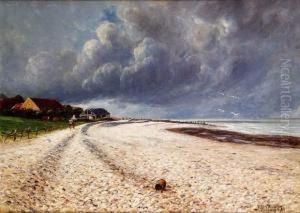Frederic Ernest Renaudot Paintings
Frederic Ernest Renaudot was a French artist known for his contributions to painting and printmaking during the late 19th and early 20th centuries. Born in 1867, Renaudot was part of a period that saw dramatic changes in the art world, including the transition from traditional academic art to more modern and experimental forms. Although not as widely recognized as some of his contemporaries, Renaudot's work encapsulates the spirit of his time, blending traditional techniques with emerging styles.
Renaudot's early career was marked by his academic training, which was typical for artists of his generation. He studied at the École des Beaux-Arts in Paris, where he was exposed to the classical principles of art and painting. However, like many of his peers, Renaudot was drawn to the innovative approaches of Impressionism and Post-Impressionism. His work began to reflect this influence, showing a keen interest in capturing light, movement, and the subtleties of color.
Despite his affinity for these newer styles, Renaudot never fully abandoned the technical rigor of his academic training. This blend of old and new is evident in his landscapes and portraits, which often exhibit a careful composition and attention to detail, while also embracing more fluid and expressive brushwork. Renaudot's prints, particularly his lithographs, are notable for their technical proficiency and artistic sensitivity, demonstrating his versatility as an artist.
Throughout his career, Renaudot exhibited his work in various salons and galleries, gaining respect among his peers and critics. However, he remained somewhat peripheral to the main currents of French modernism, perhaps due to his more eclectic approach or the overshadowing presence of more dominant figures in the art world at the time. Despite this, his contributions to French art are recognized for their quality and the unique perspective they bring to the transitional period between the 19th and 20th centuries.
Frederic Ernest Renaudot passed away in 1945, leaving behind a body of work that, while not extensive, is valued for its reflection of a pivotal era in art history. Today, his paintings and prints can be found in various collections and museums, testament to his skill and the enduring appeal of his artistic vision.
